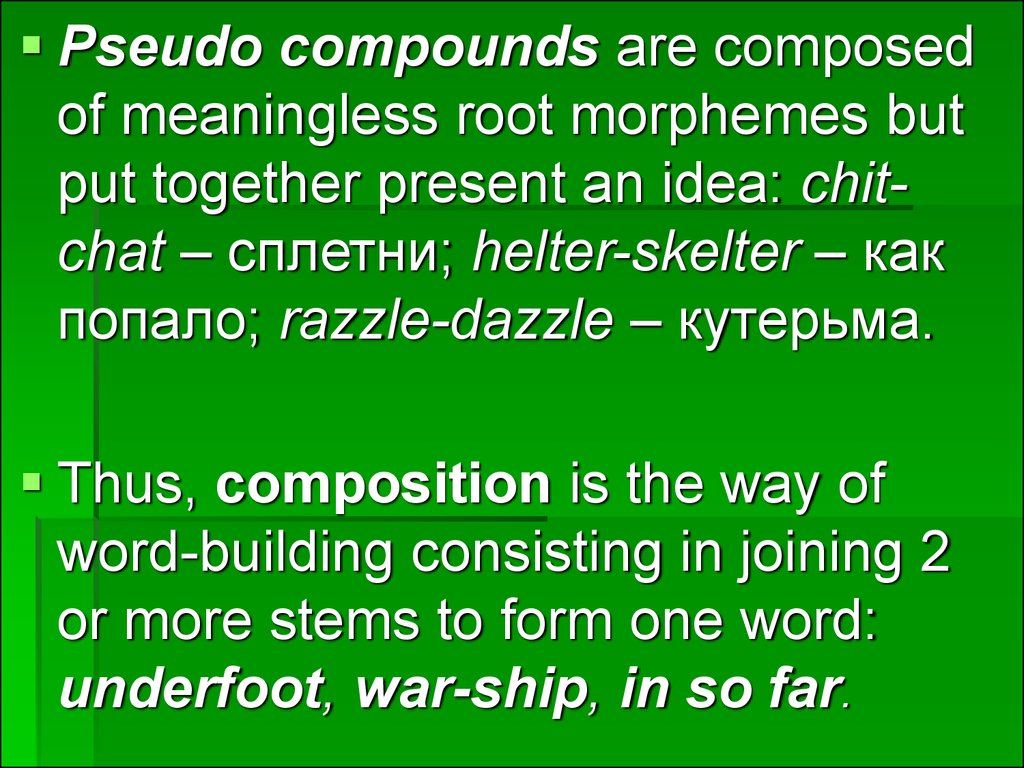Similar presentations:
Composition
1. COMPOSITION (compounding)
is the combination of two or moreexisting words to create a new word.
It is one of the most common and
important word-building processes in
English.
A compound is a unit of vocabulary that
consists of more than one lexical stem:
football, handicraft, sky-blue,
off-the-record, touch-me-not.
2.
With very few exceptions, it is anoun, a verb or an adjective.
In most compounds the rightmost
morpheme (head) determines the
category of the entire word:
greenhouse (noun);
spoon-feed (verb);
nationwide (adjective).
3. Properties of compounds
Compounds in English can be writtendifferently:
as single words – moneywise,
with a hyphen – globe-trotter and
as separate words – couch potato.
Adjective-noun compounds are characterized
by a more prominent stress on their first
component:
a `tall `boy – a `tall-boy.
Tense and plural markers are attached to the
compound as a whole (exceptions are passersby, parks supervisor, sons-in-law, etc).
4. Such criteria should be taken into account:
solid spelling –nickname; underdog,whitewash;
stress – `blue collar – `blue `collar; `green
house – `green `house;
connecting elements – handicraft,
speedometer, spokesperson;
impossibility for members of a compound to
be modified – a blackbird (дрозд); a very black
bird (очень черная птица);
semantic unity (compounds always express a
single idea) – baby-sit, home town, sweetheart.
5. There are different classifications of compounds according to:
their part of speech characteristic;the way components are joined together;
their structure;
the degree of semantic independence of
components;
the order of components (immediate
constituents);
the meaning of the whole.
6. According to the part of speech characteristic, compounds are subdivided into
nouns (night-gown, waterfall);verbs (to honeymoon, to outgrow);
adjectives (free-for-all, hardworking);
adverbs (downstairs, lip-deep);
prepositions (within, into) and
numerals (thirty-seven).
7. According to the way components are joined together, compounds are subdivided into
neutral (formed by juxtaposition)(sunflower, bestseller),
morphological (joined by a linking
element) (handicraft, microchip)
and
syntactical (joined by means of formword stems) (whodunit, face-toface, lily-of-the-valley).
8. According to their structure, compounds are subdivided into
compounds proper (earthquake, towindow-shop, sky-blue);
compound-derived (affixed) words (longlegged, video-player, absent-mindedness);
compound words consisting of 3 or more
stems (mother-in-law, good-for-nothing,
wastepaper-basket);
compound-shortened words (h-bag, Vday).
9. According to the degree of semantic independence of components, c-s are divided into
a) subordinative compounds (with1 component as a semantic centre)
– love-sick, nanny-goat, silverware;
b) coordinative compounds (with
both semantically equal
components) – Anglo-Saxon,
walkie-talkie, go-go.
10.
Subordinative relations can becomparative – snow-white;
instrumental – sunrise;
of purpose – bookshelf;
emphatic – dead-cheap;
functional – bathrobe;
sex – tomcat;
adverbial type – color-blind.
11.
Coordinative compounds fall into 3groups:
reduplicative compounds – goodygoody, go-go;
c-s formed with rhythmic stems –
walkie-talkie; chit-chat;
additive compounds – AfroAmerican, secretarystenographer.
12. According to the order of components (ICs), compounds are subdivided into
syntactic (with the direct order) (tofrontpage, giver-away, fair-haired)
and
asyntactic (with the indirect order) (to
book-hunt, blood-thirsty, theatregoer).
13. According to the meaning of the whole, compounds are divided into
idiomatic – night-cap (a drinktaken before going to bed at night),
butterfingers (a clumsy person)
and
non-idiomatic – homeland,
swimming-pool, speedometer).
14.
Pseudo compounds are composedof meaningless root morphemes but
put together present an idea: chitchat – cплетни; helter-skelter – как
попало; razzle-dazzle – кутерьма.
Thus, composition is the way of
word-building consisting in joining 2
or more stems to form one word:
underfoot, war-ship, in so far.














 english
english








